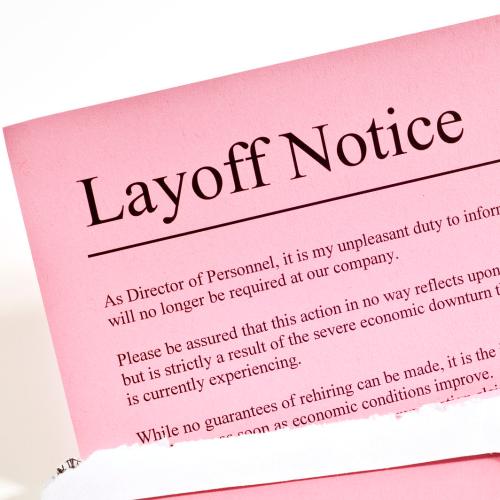Policymakers, businesses, and institutional leaders have deliberately shut down economic activity as a necessary public health measure to save lives and reduce long-run economic costs. One consequence has been a sizable spike in job losses. Today, unemployment insurance (UI) claims for the week ending March 21, 2020 totaled a record-breaking 3,283,000 almost 5 times the highest previous weekly total. However, the shutdown that led to many of these layoffs will be temporary, and our economic policy response seeks to make the economic disruption just as temporary. This analysis shows that unemployment duration is substantially shorter for workers who are temporarily laid off and provides hope that employment relationships can be maintained—at least for a certain length of time—after a temporary shutdown of the economy.
One important step toward answering this question is fully understanding the layoffs that have already begun in massive numbers. How many of these layoffs will be temporary—allowing for straightforward recall of workers to their previous jobs—and how many will be permanent, necessitating prolonged job search and readjustment? Because the current situation is largely unprecedented, the public policy response still uncertain, and the data are not yet available, no definite answer can be provided. But we can gain insight by examining temporary and permanent layoffs during pre-pandemic periods.
Workers “on layoff” are defined by the Bureau of Labor Statistics (BLS) as those workers who expect to return within six months or have been provided with a specific recall date; we refer to these as temporary layoffs. A permanent layoff, by contrast, is what we call a job loss that does not satisfy one of these conditions, and typically ends with a worker finding a job with a new employer or leaving the labor force. The BLS estimated that 801,000 Americans were on temporary layoff and 1,279,000 Americans were on permanent layoff in February 2020. (The sum of the two is smaller than the number of unemployed because those who quit jobs, those who entered the labor force, and those who ended temporary jobs are not included in those numbers.) Of course, these numbers will increase dramatically in the coming months as the fallout of the COVID-19 crisis begins to appear in the data.
In figure 1, we compare the duration of both temporary and permanent layoffs from July 2008 to June 2009, showing the percent of each group’s unemployment that has lasted a given number of weeks at the time when a worker is surveyed. (We choose this time period because it is the most macroeconomically similar recent comparison period for early 2020; layoffs during the Great Recession were especially high during this period.) It is clear that temporary layoffs tend to be much shorter in duration than permanent layoffs (for which workers have no expectation of return to the previous employer). Fifty-two percent of workers on temporary layoff during 2008–09 reported an unemployment duration of 4 weeks or less. By contrast, only 21 percent of workers on permanent layoff reported a duration of 4 weeks or less. Relatively few workers (36 percent) on temporary layoff reported durations of 8 weeks or more, while 73 percent of those permanently laid off reported at least an 8-week duration.

One important note is that these are reported numbers of weeks for the currently unemployed, and do not represent completed spells of unemployment. Workers on temporary layoff can convert to a “permanent” status if they no longer believe they will return to their previous employer. In other words, short temporary layoff durations are not always followed by re-employment; they can also be followed by permanent layoff status or labor force exit.
A final consideration is that the labor market, and in particular the way that employers use temporary layoffs, may have changed since 2008. Therefore, in figure 2 we examine 2019, a recent time period that does not immediately follow a spike in layoffs. In 2019, 58 percent of workers on temporary layoff reported an unemployment duration of 4 weeks or less. Only 27 percent of workers on permanent layoff reported a duration of 4 weeks or less. Thirty percent of those on temporary layoff reported durations of 8 weeks or more, compared with 65 percent of those permanently laid off.

During the Great Recession, both temporary and permanent layoffs resulted in longer spells of unemployment. But the core insight from figures 1 and 2 is that workers on temporary layoff have historically spent much less time in that status than workers on permanent layoff. Recall to a previous employer has been common: one estimate shows that more than 40 percent of all those who transition from employment to unemployment ultimately end up returning to their previous employer. But temporary layoff spells can also culminate in permanent separation from the previous employer, which is another factor accounting for the short durations of temporary layoff that we show in figures 1 and 2.
The economic policy response to COVID-19 should be intended to maximize the share of workers who return to their previous employer. Subsidizing employers who retain or rehire their workers, providing generous UI benefits that keep workers in the labor market, and a host of other policy actions aim to preserve the web of employment and business relationships that existed prior to the pandemic. We may therefore hope and expect for a much higher share than 40 percent to return to their previous employers. But we should also keep in mind that temporary layoffs are typically limited in duration. As time passes without workers being recalled to their employers, those layoffs may stand a greater chance of becoming permanent.
The Brookings Institution is committed to quality, independence, and impact.
We are supported by a diverse array of funders. In line with our values and policies, each Brookings publication represents the sole views of its author(s).








Commentary
How long can we expect temporary layoffs to remain temporary?
March 26, 2020